Learning Objectives
By the end of this section, you will be able to:
- Describe the four different Creative Commons License components.
- Explain why some CC-licensed content might not be considered OER.
As we mentioned in the previous chapter, Creative Commons (CC) licenses allow you to explain, in plain language, how your creative works can be reused. These licenses act as explicit, standing permissions for all users.[1]
The Four Components of Creative Commons Licenses
| Attribution (BY) Proper attribution must be given to the original creator of the work whenever a portion of their work is reused or adapted. This includes a link to the original work, information about the author, and information about the original work’s license. | |
| Share-Alike (SA) Iterations of the original work must be made available under the same license terms. | |
| Non-Commercial (NC) The work cannot be sold at a profit or used for commercial means such as for-profit advertising. Copies of the work can be purchased in print and given away or sold at cost. | |
| No Derivatives (ND) The work cannot be altered or “remixed.” Only identical copies of the work can be redistributed without additional permission from the creator. |
These elements can be mixed and matched to create a total of six Creative Commons licenses.[2]
Choosing a License
Choosing a CC license can be confusing at first, but the online Choose a License tool can help. This tool generates a license based on which rights you want to retain and which you would like to give to users. For example, if you want to share your work and allow others to adapt it, but you do not want others to be able to sell your work, you might consider using the CC BY NC license.
Before you choose a license, keep in mind that an OER should be able to exercise all the 5 Rs of open content we discussed in the previous chapter. Not all of the CC licenses meet this definition. Specifically, the CC BY ND and CC BY NC ND licenses do not allow revising or remixing content, two of the most significant freedoms of OER for many instructors.
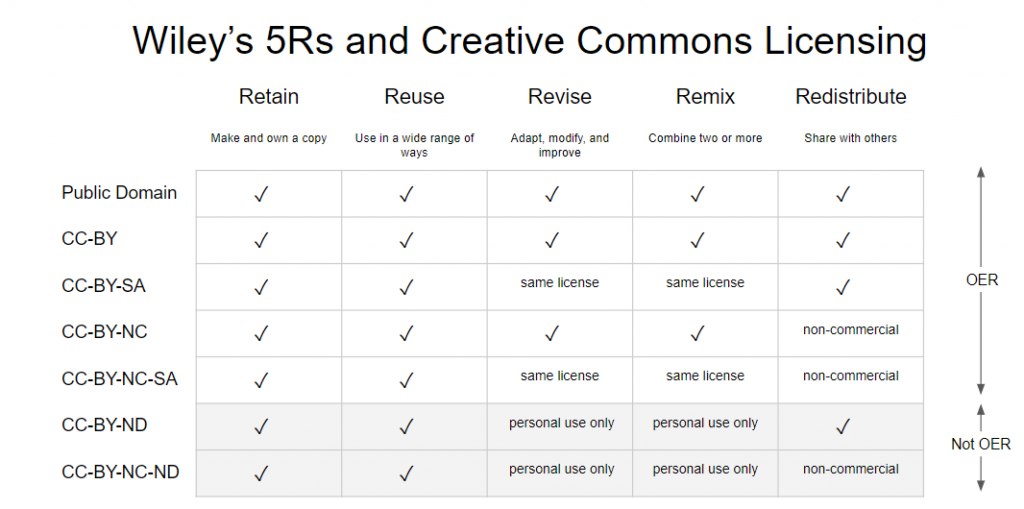
Implementing a CC License
Creative Commons has an online Marking Guide that demonstrates how to mark your CC license on different types of media. Making your license obvious on whatever item you are sharing is an important part of the dissemination process for OER: otherwise, users won’t know what license you’ve chosen! No matter the format, there are some standards you can follow:
- Make it clear
- Make it visible
- Provide links (to the license and the work)
The Four “Open” CC Licenses
There are strengths and weaknesses to each Creative Commons license you might apply to your OER. To help you make an informed decision, a short description of each license that can be applied to OER is provided below.
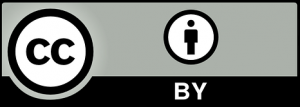 CC BY
CC BY
Strengths
- The CC BY license is the most popular and open license provided by Creative Commons.
- By requiring attribution and nothing else, your CC BY work will be easy for others to adapt and build upon.
- CC BY is often the default choice for open publications. Youtube uses the CC BY 3.0 license as their single “Creative Commons” option.
Weaknesses
- Because CC BY allows for easier sharing and adaptation, it also leaves the creator with less power over their work. When you use a CC BY license, you cannot be certain that your work will remain open or that your work will be reused for projects you support.
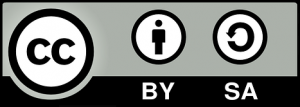 CC BY SA
CC BY SA
Strengths
- The CC BY SA combines the openness of CC BY license with the caveat that an item remains open under the same license when adapted.
- The CC BY SA license is the second most popular license, and the license used by Wikipedia for their articles.
Weaknesses
- Because the CC BY SA license requires that adapted content be shared under the same license, it can be difficult to adapt or to remix works licensed CC BY SA.[3]
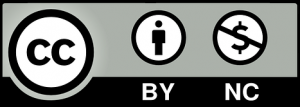 CC BY NC
CC BY NC
Strengths
- The CC BY NC license gives the creator of a work complete control over any commercial reuse of their work.
- As a user, you can adapt and remix CC BY NC works so long as your new works provide attribution to the original author and do not turn a profit.
Weaknesses
- Some users may be concerned about what they are allowed to do with your CC BY NC work and where the commercial “line” is drawn. This topic is addressed in more depth in our OER in Print chapter.
 CC BY NC SA
CC BY NC SA
Strengths
- CC BY NC SA is the most restrictive license that can be used for OER and gives you the most control over its adaptations.
- Some creators apply this license out of concern for their works being “scooped” by commercial publishers.
Weaknesses
- Because of its requirements, the CC BY NC SA license is the hardest to adapt, remix, or build upon.
- If you hope to leverage the open community to promote and share your content, this license may be a deterrent for potential partners.
You can learn more about the individual CC licenses on the Creative Commons website.
If you want to reuse an existing OER, there are some aspects of CC licenses you should keep in mind. Although there are different rules for each, every CC license includes the Attribution component which requires that users provide proper attribution for an original work being shared or adapted.
Attribution vs Citation
Attribution is a similar process to citing academic works in a paper, but there are some key differences. The following table outlines some of the ways in which citations and attribution are similar and different:
| Citation | Attribution |
|---|---|
| Purpose is academic (e.g. avoiding plagiarism) | Purpose is legal (e.g. following licensing regulations) |
| Does NOT typically include licensing information for the work | Typically includes licensing information for the work |
| Used to quote or paraphrase a limited portion of a work | Used to quote or paraphrase all or a portion of a work |
| Can paraphrase, but cannot typically change the work’s meaning | Can change the work under Fair Use or with advance permission (e.g., under most CC licenses) |
| Many citation styles are available (e.g., APA, Chicago, and MLA) |
Attribution statement styles are still emerging, but there are some defined best practices |
| Cited resources are typically placed in a reference list | Attribution statements are typically found near the work used (e.g., below an image) |
In this chapter, we have discussed how Creative Commons licenses work and how you can use these licenses for publishing or sharing open content. In the next chapter, we’ll explore how you can find existing OER to use in your course.
- Attribution: This chapter was adapted from The ABOER Starter Kit by Technologies in Education at the Faculty of Education, the University of Alberta, available under a Creative Commons Attribution 4.0 International License. ↵
- Note that the No Derivatives and Share Alike components are incompatible and cannot be combined under one license. ↵
- TheOGRepository. "Creating OER and Combining Licenses." YouTube video, 9:16. September 5, 2012. https://www.youtube.com/watch?v=Hkz4q2yuQU8 ↵
Learning Objectives
By the end of this chapter, you will be able to:
- Explain why students might want to access a print copy of an OER.
- Identify three options for acquiring an OER in print.
Physical copies of course materials are sometimes preferred by both students and instructors. Since OER are typically created as digital objects first, it can be difficult to picture them as physical items, but many OER come in low-cost print versions as well. In this chapter, we'll review some of the reasons why and how you might offer a print option for your text-based OER.
Why Print?
There are many reasons why your students might want to access an OER in print, even at a price. A few of these are listed below:
- Students who do not own a laptop might want to have a print copy of their text for use in the classroom.
- Some students have issues with eye strain when reading on computer screens.
- Some students find it easier to retain information from print texts.
- Some students (and instructors!) prefer having physical manuals for use in labs.
Although not all students will want to purchase your materials in print, having the option available might be a worthwhile endeavor for your course.
Purchasing Copies
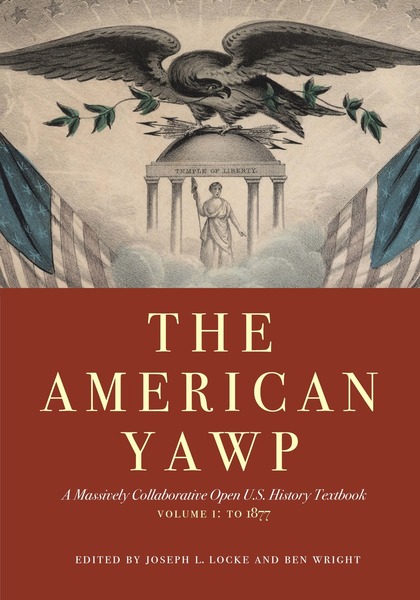
One option for accessing OER in print is to purchase publisher-produced copies. For example, OpenStax, a Rice University-based open textbook publisher, provides bulk printing through textbook providers that contract with university bookstores. Campus bookstores can order copies of OpenStax textbooks and other OER which have print copies available for sale.
The American Yawp is a prime example of a university press-distributed open textbook. First released in print in 2018, the massively collaborative United States History textbook is one of the most popular history OER in use today. New editions of the text are released regularly and the book's update history is provided on its host website.
Even if the publisher of your chosen OER does not sell physical copies of their resource, you can commission copies through third-party platforms such as Lulu.com or Amazon. This can be an excellent option if you plan on rearranging chapters of your chosen text or if you are compiling a reader of various open resources.
Warning: Before ordering print copies of your text, keep in mind how your use of print materials will affect your students' engagement with your course.
Considerations for courses using OER in print
- Should students be required to purchase a hard copy?
- Could you easily print and lend out copies of the OER to your students?
- How will you explain to students where the OER can be found for free online?
Printing on Campus
If the OER you want isn't available to purchase in print and you don't want to commission print copies on a third-party platform, you can also consider printing copies on campus.
University Printing Services
Campus Printing Services is an excellent option for getting a text-based resource ready for print. Keep in mind that the price of your resource will vary depending on the printing specifications you choose (e.g., ring-bound, softcover, black and white, full color). To make things easier for your students, you should work with printing services and your bookstore to get your book in the best possible format for your needs.[1]
Student-Printed Copies
If you aren't certain whether your course could benefit from using OER in print, you can choose not to offer a print version. In this case, individual students can print personal copies of the text for themselves. Students provided with print credits on campus can print individual chapters or sections of your material or they can print the full text of your book or manual at a store like Staples.
The Non-Commercial Discussion
There is a cost to print any resource, even an open one. Since the Non-Commercial (NC) Creative Commons licenses do not permit reuse for commercial purposes, this might make you think that you cannot access Non-Commercial OER in print; however, that is not the case. Open educational resources with CC BY NC licenses can be printed and sold at cost or with standard university bookstore markups, but they cannot be sold for a profit.[2] Some quick rules of thumb for using Non-Commercial CC-licensed OER content are outlined below:
- The CC BY NC license gives the rightsholder of a work complete control over its commercialization. The author can sell copies for a profit, but no one else can unless the author gives express permission.[3]
- The CC BY NC license allows for copies of a work to be sold at cost. Printing copies of another creator's work through a third party like Staples or Lulu.com is allowed under the CC BY NC license, as long as you do not sell those copies for a profit.
- Items licensed CC BY NC can be distributed to students by a for-profit company or private university without breaking the terms of its license: what matters is the characterization of the use, not the user.
